-
Table of Contents
Are Employees Happier With Lower Salaries and Better Well-being?
In today’s fast-paced corporate world, the relationship between salary and employee happiness is a topic of ongoing debate. While higher salaries are often perceived as the primary motivator for job satisfaction, emerging research suggests that well-being and workplace culture may play a more significant role in overall happiness. This article explores whether employees are indeed happier with lower salaries if it means better well-being and a supportive work environment.
The Salary-Happiness Paradox
Traditionally, salary has been viewed as a key indicator of job satisfaction. However, studies indicate that the correlation between salary and happiness is not as straightforward as one might think. According to a 2021 study published in the journal *Social Indicators Research*, once an individual’s income reaches a certain threshold—around $75,000 per year—additional income has diminishing returns on happiness. This phenomenon is often referred to as the “salary-happiness paradox.”
Understanding Well-being in the Workplace
Well-being encompasses various aspects of an employee’s life, including mental health, work-life balance, and job satisfaction. Companies that prioritize employee well-being often see a more engaged and productive workforce. Here are some key components of workplace well-being:
- Work-Life Balance: Employees who can balance their professional and personal lives tend to report higher levels of satisfaction.
- Supportive Culture: A positive workplace culture fosters collaboration and support among employees, leading to increased morale.
- Opportunities for Growth: Employees value opportunities for professional development and career advancement, which can enhance their sense of purpose.
- Health and Wellness Programs: Companies that invest in health initiatives often see lower absenteeism and higher employee engagement.
Case Studies: Companies Leading the Way
Several companies have successfully implemented strategies that prioritize employee well-being over high salaries, resulting in happier employees. Here are a few notable examples:
- Buffer: This social media management platform offers transparent salaries and emphasizes a healthy work-life balance. Employees enjoy flexible hours and unlimited vacation days, leading to high levels of job satisfaction.
- Salesforce: Known for its commitment to employee well-being, Salesforce provides mental health resources, wellness reimbursements, and a strong focus on diversity and inclusion. The company has consistently ranked high in employee satisfaction surveys.
- Patagonia: This outdoor clothing company is famous for its environmental initiatives and employee-friendly policies. Patagonia offers on-site childcare and encourages employees to pursue their passions, resulting in a loyal and motivated workforce.
The Role of Employee Engagement
Employee engagement is closely linked to happiness and well-being. Engaged employees are more likely to be productive, innovative, and committed to their organization. According to Gallup’s State of the Global Workplace report, organizations with high employee engagement levels experience 21% higher profitability and 17% higher productivity.
To foster engagement, companies can:
- Encourage open communication and feedback.
- Recognize and reward employee contributions.
- Provide opportunities for team-building and collaboration.
- Invest in training and development programs.
Conclusion: Finding the Right Balance
The question of whether employees are happier with lower salaries and better well-being does not have a one-size-fits-all answer. While competitive salaries are essential, they are not the sole determinant of employee happiness. Companies that prioritize well-being, foster a positive workplace culture, and engage their employees often see higher levels of satisfaction, even if their salaries are not the highest in the industry.
Ultimately, organizations must strive to find the right balance between compensation and well-being. By investing in their employees’ overall happiness, companies can create a more productive and loyal workforce, leading to long-term success. For more insights on employee well-being and workplace happiness, consider exploring resources from the Gallup Organization and other industry leaders.

